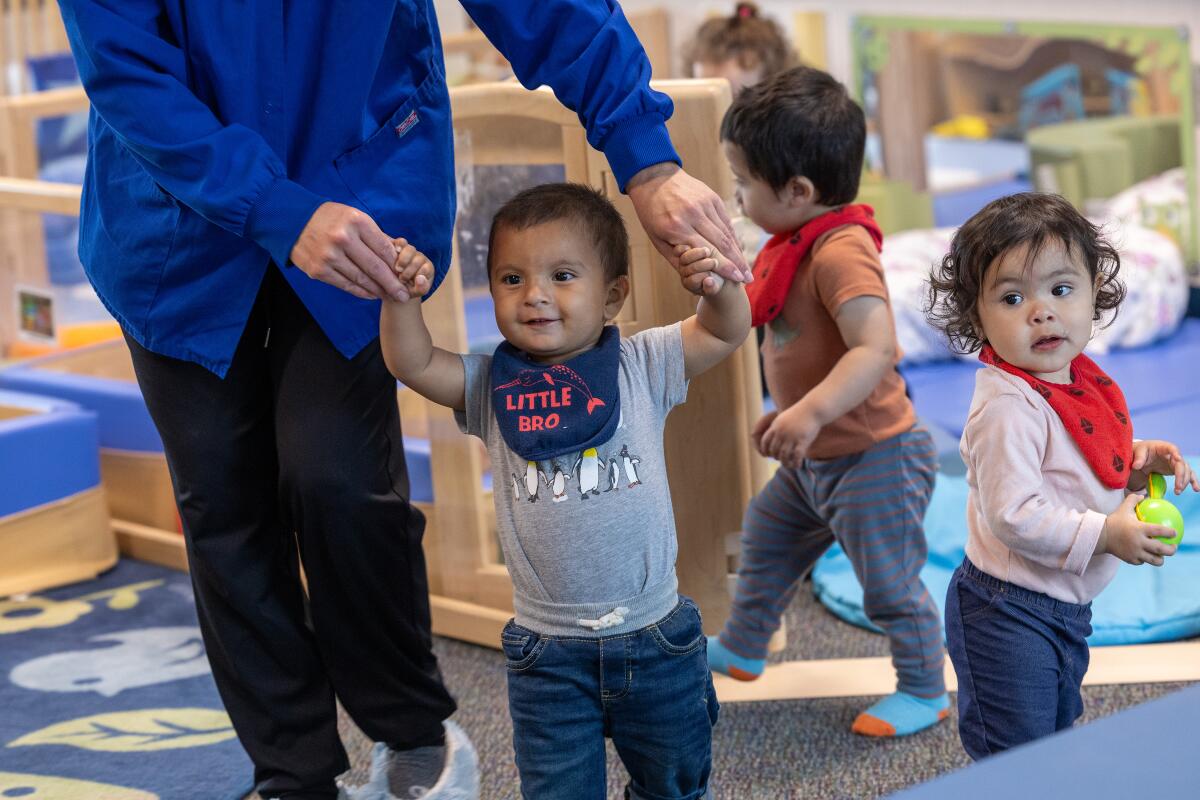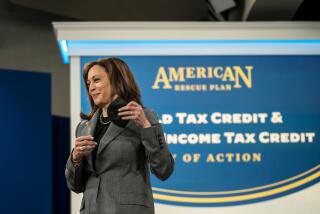Child care is a ‘textbook example of a broken market.’ Where do Harris, Trump go from here?

- Share via
Child and family policies have catapulted to a prime spot in the presidential race as Kamala Harris promotes a new care economy for working families and former President Trump touts his past record.
“We see a future with affordable health care, affordable child care and paid leave. Not for some, but for all,” Harris told a crowd at the American Federation of Teachers convention in Houston, just days after she became the presumptive Democratic nominee.
The Democratic Party platform released Sunday, right before the Democratic National Convention in Chicago, includes proposals to create a universal preschool program for 4-year-olds, provide child care for less than $10 per day for millions of working families, and restore the pandemic-era expanded child tax credit. Harris also proposed adding an extra $6,000 tax credit for families with newborn babies.
Both Harris and Vance say they want to boost the popular child tax credit. The move could reduce child poverty rates, but could also be expensive.
As president, Trump signed legislation that provided a major increase to child-care block grants to states and recently highlighted his increase of the child tax credit in 2017. But he did not mention child care during his speech at the Republican National Convention, and the 2024 GOP platform also did not mention this issue.
Still, the promise of affordable child care has long been a point of bipartisan agreement, a rare issue that has not been overly politicized. “Both the right and the left see the need for children to be taken care of while parents work,” said Christy Felling, director of communications for the nonprofit First Five Years Fund. “But as with everything, the devil is in the details.”
So what might affordable child care actually look like under a Democratic or Republican administration, and why is the current situation so dysfunctional? An examination of past proposals and actions, as well as interviews with child-care experts across the country, reveals the basic contours of how an affordable system might differ from the child-care market the U.S. has today.
Engage with our community-funded journalism as we delve into child care, transitional kindergarten, health and other issues affecting children from birth through age 5.
The ‘broken child-care market’
Former U.S. Treasury Secretary Janet L. Yellen described the child care system in 2021 as “a textbook example of a broken market.”
Child-care employees are some of the lowest-paid workers in the economy, at an average of $13.22 an hour. There is near-universal agreement among early-childhood experts that high-quality care requires a consistent, nurturing relationship with an attentive caregiver. Yet low wages lead to high staff turnover, as many workers leave beloved jobs for better pay in sectors including retail and, in California, $20-an-hour fast-food outlets.
Black and Latina child-care workers are paid less and given fewer leadership roles than their co-workers, despite making up much of the early childhood workforce.
Yet despite these low wages, the price of care is astronomical for families, and can outpace college tuition and even mortgage payments in many states.
In California, for example, placing an infant in a private child-care center cost an average of $19,547 per year in 2021, according to the nonprofit Child Care Aware. That’s 15% of the median income for a married couple in the state, and 47.6% of median income for a single parent.
“No one in their right mind would design the system we have,” said Kathryn Anne Edwards, a labor economist and policy consultant who studies the child-care market.
Low-income families can receive government assistance to help cover costs, or attend free government-funded programs including Head Start and state preschools. Seventeen percent of children under age 5 in California are served by government-subsidized child-care programs.
Find expert tips, book recommendations and resources geared toward parents of kids just starting transitional kindergarten.
But for California families earning more than $113,292 a year, who don’t qualify for subsidized care, child care is an individual responsibility.
“What we hear continuously [from families] is that, ‘It’s child care or housing. It’s one or the other. I can’t afford to do both,’” said Miriam Calderón, chief policy officer at Zero to Three, a nonprofit that focuses on early childhood. One in five stay-at-home moms report turning down a job opportunity because they could not afford child care, according to a recent Morning Consult poll.
And in many places in the nation, there isn’t enough child care to go around, with “child-care deserts” in rural and urban areas. In Los Angeles County, for example, there are only enough licensed child-care slots to serve 4% of infants and toddlers. Transitional kindergarten has helped bring affordable care to more 4-year-olds in the state, but the program has also disrupted the rest of the child-care system, with open slots for older children, but a shortage of spots for babies, whose care costs more.
“We just haven’t yet made the decision that early care, early learning programs should fall into the same bucket as kindergarten to 12th-grade education or roads and bridges or emergency services,” said Hailey Gibbs, senior analyst for early-childhood policy at the Center for American Progress think tank. “I think we’re in the midst of this sort of cultural shift.”
L.A.’s child-care industry sees big disruptions and uncertainties brought on by a dramatically shifting landscape. Enrollment is still down with no signs of a rebound.
What would an affordable child-care market look like?
The new Democratic policy platform closely resembles two bold proposals for an affordable system put forward by the Biden administration that envision child care as more of a public good, in which the government would pay for a large chunk of families’ child-care costs.
The Build Back Better bill from 2021 would have established a universal preschool program and capped a family’s child-care spending at 7% of income for anyone earning up to 250% of state median income. In California, that’s more than $277,000 for a family of four. Families earning more would have continued to pay sticker price. The overhaul would have cost an estimated $380 billion over six years.
The legislation passed the House but died in the Senate after Sen. Joe Manchin III (I-W. Va.), who was then a Democrat, declined to support it.
A second plan, which was proposed in March as part of President Biden’s fiscal year 2025 budget proposal, would create a universal preschool program and cap child-care spending for lower- and middle-income families at $10 per day, at an estimated cost of $600 billion over 10 years. This model is similar to a universal $10 per day child-care program that Canada is implementing, as well as the systems in the several Nordic countries.
Although these broad overhauls have not been passed, the Biden administration has enacted several new policies on child care, including capping family costs for 100,000 low-income children receiving government subsidies for child care. The American Rescue Plan signed by Biden in 2021 also provided $39 billion in new funding for the child-care industry that kept it afloat during the height of the COVID-19 pandemic but has since expired.
The Republican plan on child care
Then-President Trump signed a historic $2.37-billion increase in funding for federal child-care grants to states to help families afford child care in 2018. He also signed an extra $13.5 billion in one-time funding to shore up the child-care sector during the pandemic. And in 2017, he doubled the child tax credit for 39 million middle-income families as part of the Trump Tax Cuts, an action that he wrote about Wednesday in a post on his Truth Social website.
Vice presidential candidate JD Vance recently suggested expanding the child tax credit — which can be used by families to pay for expenses including rent, child care, groceries and toys — to $5,000 per child per year.
The GOP campaign platform, however, does not mention child care nor expanding the child tax credit beyond current levels. And when asked to address the issue of child care in his debate against President Biden, Trump ignored the question and instead focused on his golf game.
“I think everyone agrees investing in the next generation is important. But when it comes to who does the care work and who pays for it, I think that’s really when we start to see a departure in alignment,” said Gibbs of the Center for American Progress.
Many conservatives see child care as “a private family issue that should be paid for and dealt with privately by families,” she said. Project 2025, the conservative Heritage Foundation’s playbook, would eliminate the Head Start program, which serves more than 800,000 low-income children across the country.
Parents can choose from an assortment of early childhood programs, ranging from child care to preschool to transitional kindergarten. Here’s what they offer.
The plan also claims — without evidence — that “children who spend significant time in day care experience higher rates of anxiety, depression, and neglect as well as poor educational and developmental outcomes.” Rather than providing universal child care, Project 2025 instead calls for funding to go “to parents either to offset the cost of staying home with a child or to pay for familial, in-home childcare.”

Is affordable child care possible?
“Any candidate that wants to be taken seriously would be wise to have a very strong child-care proposal,” said Calderón, of Zero to Three. “These are policies that families want and they’re popular with businesses.”
A Zero to Three poll last year found that 86% of parents say it should be a priority for Congress to secure funding for the child-care system, and nearly half said the government is most responsible for challenges in the system.
But a major child-care overhaul would require bipartisan support in Congress and a reimagining of child care as a public good rather than a private family responsibility — and a willingness to spend billions more on the nation’s youngest children and their families.
“Tinkering with the existing system of vouchers and tax credits will only keep wages low and perpetuate inequities,” said Elizabeth Pufall Jones, a director at the Center for the Study of Child Care Employment at UC Berkeley. “A publicly funded system with universal access is the only way to address equity.”
If the political will can be mustered, “almost all of the pieces are there,” said Edwards, including an existing process in which the federal government gives states money to administer child care. “If you wanted universal access to child care in 24 months, it would be hard. But we could do it.”
Deciding between preschool and transitional kindergarten isn’t easy for parents. Here’s how eligibility, structure and academic environment may differ.
States could each determine a formula for how much it costs child-care centers to provide care and pay their employees a fair salary, and then set a rate for each market. Edwards favors a system that would charge $10 to $15 a day for care to all parents — including those with higher income — with the federal government and states paying providers the rest. Families could still opt out in favor of private options.
The government could ensure high-quality care by making reimbursements to child-care facilities contingent upon meeting certain requirements for adequate staffing, training and even requiring that children undergo developmental screenings, Edwards said.
Such a system would cost the country more than $100 billion a year, said Elliot Haspel, a senior fellow at Capita, a family policy think tank.
“That sounds like a giant number until you consider that we spend $800 billion a year on public education in K-12,” he said. “You cannot cheap your way to an effective child-care system.”
A piecemeal approach
Felling, of the First Five Years Fund, is focused on nearly a dozen child-care bills expected in the fall that would take a more piecemeal, bipartisan approach to modifying the existing child-care system. One effective approach, Felling said, is to modify the existing tax code to increase the deductions that families and employers can take for child care.
Parents can currently set aside pretax dollars in a flexible spending account to spend on child-care costs, for example. But the amount of money they can save hasn’t changed since 1986. A recent bipartisan proposal would have doubled the amount to $10,000. Another proposal would increase the maximum tax credit for employers that provide child care to their workers to $500,000 from $150,000.
There are also bipartisan proposals to increase federal funding for Head Start and child-care block grants to states. Others address the workforce shortage by increasing wages for child-care workers and offering grants to help train a new generation of providers.
“We need to innovate and look at the big swings, but families need more supports, providers need more supports right now,” Felling said.
This article is part of The Times’ early childhood education initiative, focusing on the learning and development of California children from birth to age 5. For more information about the initiative and its philanthropic funders, go to latimes.com/earlyed.
More to Read
Sign up for Essential California
The most important California stories and recommendations in your inbox every morning.
You may occasionally receive promotional content from the Los Angeles Times.


















